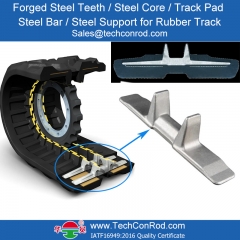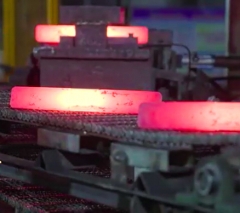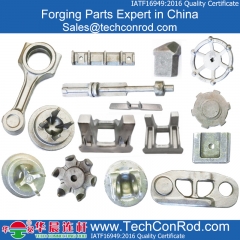 +86-151 9217 7108
+86-151 9217 7108
 +86-151 9217 7108
+86-151 9217 7108

High quality steel Die Forging parts with material 40Cr 42CrMo and C70S6
read more
High quality steel Die Forging parts with material 40Cr 42CrMo and C70S6
read more
High quality steel forging parts with material 40Cr 42CrMo and C70S6
read more
OEM high performance steel forging parts at China price.
read more
The inspection methods for forged parts include chemical composition analysis, mechanical property test, low magnification inspection, metallographic high magnification inspection and nondestructive testing.
Chemical composition analysis
The general chemical composition analysis mainly includes the content of carbon, manganese, silicon, sulfur and alloy elements. The forgings shall be sampled from the equivalent riser end. In order to understand the degree of segregation, important parts shall be sampled from the water and riser end. For special parts or defects, it is often necessary to analyze the contents of gases, inclusions and trace impurities for quality confirmation or research.
Mechanical property test
The mechanical property tests commonly used by forging factories are hardness, drawing, impact and bending tests. From the performance data, we can find the problems of the material. Bubbles, porosity, cracks, grain size and temper brittleness in the steel can often be reflected on the fracture surface of the mechanical property sample.
Macroscopic inspection
Sulphur printing, acid pickling and fracture are commonly used as low magnification inspection items. Sulfur print can show the distribution of sulfur on the cross section; Pickling can show various macroscopic defects such as component segregation, porosity, shrinkage, subcutaneous bubbles, inclusions, peeling, white spot cracks, etc. on the section; Fracture inspection can find defects that can not be revealed by sulfur printing and pickling, which is a simple and applicable method.
Metallographic high power inspection
This method is widely used for microscopic inspection and also for studying the microscopic characteristics of macroscopic defects. It is to use an optical microscope to observe the prepared metallographic sample at a magnification of 50 to 2000 times, and check the inclusion, metal microstructure and grain size.
Non-destructive testing
The commonly used methods include magnetic powder, fluorescence, coloring, ray, eddy current and ultrasonic. The correct selection of flaw detection methods for comprehensive and detailed inspection of the surface and internal defects of forgings can accurately determine the size, quantity and distribution of defects. In the quality inspection of forgings, nondestructive testing has become one of the most important methods.
 online
online 0086-635-4560298
0086-635-4560298 0086-635-4560298
0086-635-4560298 info@techconrod.com
info@techconrod.com +86-151 9217 7108
+86-151 9217 7108